Select Language
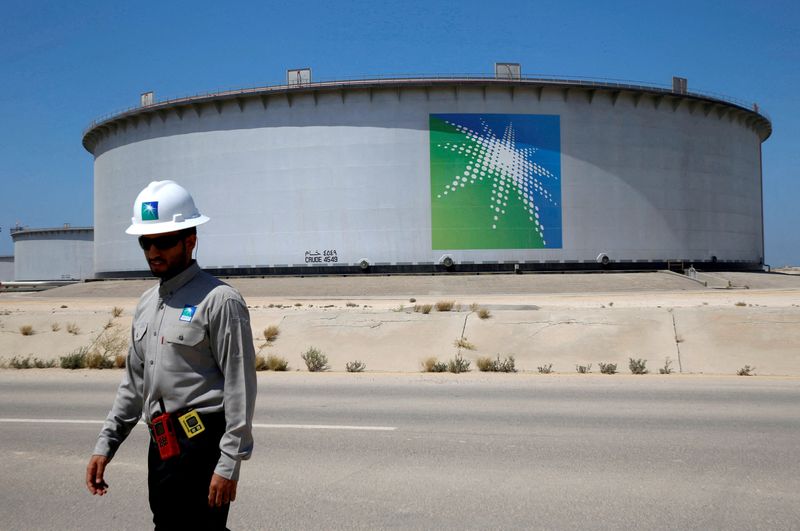
By Yousef Saba and Rachna Uppal
DUBAI (Reuters) -Saudi Arabia faces the risk of an economic contraction this year following its decision to extend crude production cuts, highlighting its still heavy reliance on oil as reforms to diversify are slow moving.
Riyadh says it aims to stabilise the oil market by extending a voluntary oil output cut of 1 million barrels per day until the end of 2023. Its announcement on Tuesday sent oil prices above $90 for the first time this year, but they are below average prices of around $100 a barrel last year in the wake of Russia's invasion of Ukraine.
Declining oil production and revenue this year could see Saudi Arabia's economy shrink for the first time since 2020 at the height of the COVID-19 pandemic, although a hefty dividend from state oil producer Saudi Aramco (TADAWUL:2222) should provide a cushion for public finances.
Cutting oil output for another three months, on top of production cuts earlier in the year, translates into a 9% fall in production in 2023 - the biggest production drop in nearly 15 years for OPEC's de facto leader - said analyst Justin Alexander at Khalij Economics.
Monica Malik, chief economist at Abu Dhabi Commercial Bank, now sees Saudi gross domestic product (GDP) contracting 0.5% this year, revising her forecast from last month of 0.2% growth this year, while Alexander said non-oil growth would need to average about 5% this year to maintain growth.
"This was actually precisely the growth rate in H1, but leading indicators such as the PMI (purchasing managers' index) have pointed to a modest slowdown, so that might be hard to sustain in H2. As a result a small real GDP contraction is looking likely," Alexander, also Gulf analyst at GlobalSource Partners, said.
Last year the Saudi economy grew 8.7% and generated a fiscal surplus of 2.5% of GDP, its first surplus in nine years as oil soared to highs near $124. This year the government has forecast a surplus of 0.4% of GDP, but some economists say even that may be optimistic.
Saudi Aramco, 90% government owned and awash with cash after last year's boom, said last month it would fork out a near $10 billion dividend to shareholders in the third quarter from its free cash flow - the first of several extra payouts on top of its expected more than $150 billion base dividend for 2022 and 2023 combined.
"Even so, we think that the government will run a budget deficit of 1.5% of GDP this year – well below the Budget estimate for a 0.4% of GDP surplus," James Swanston of Capital Economics said in a note.
The Saudi finance ministry did not immediately respond to a request for comment.
The kingdom's deficit stood at 8.2 billion riyals ($2.19 billion) for the first half of this year.
An official from the International Monetary Fund, which had forecast a 1.2% of GDP deficit this year, said on Thursday the budget would be closer to balance as a result of the extra Aramco payout and, unlike a growing number of economists, the IMF also believes the economy will manage slight growth this year.
PIF KEEPS SPENDING
Growth in the non-oil economy remains strong for now.
The Public Investment Fund (PIF), the sovereign wealth fund tasked with driving Saudi Arabia's ambitious Vision 2030 economic blueprint, has spent billions on top global soccer stars, golf, tourism and entertainment, and electric vehicle makers.
"Certainly, we see no signs that the Public Investment Fund's acquisition streak is cooling," RBC Capital Markets said in a note.
PIF did not immediately respond to a request for comment.
Still, reforms and state-led investment have seen the share of the non-oil sector's contribution to GDP rise to 44% of GDP last year, up just 0.7 percentage point from 2016.
"I think the reality has sunk in that the pace of change cannot move as quickly as had been hoped and the economy remains dependent upon hydrocarbons and will do so for some time," said Neil Quilliam, associate fellow at Chatham House in London.
Up to $50 billion worth of fresh Aramco shares could be offered on the Riyadh bourse before the end of the year, according to reports, generating vast funds that could be spent on big projects. The government has transferred 8% of Aramco to PIF and one of its subsidiaries.
PIF's funding comes from capital injections and asset transfers from the government, debt and earnings from investments. However, it reported a loss of $15.6 billion last year, mainly due to its SoftBank (TYO:9984) Vision Fund I investment and a wider market downturn, especially in tech.
"So far PIF investments haven't proven to be as fruitful as had been hoped and neither has the country attracted the FDI (foreign direct investment) it had hoped either... So Aramco is going to be the horse that they keep on beating," Quilliam said.
($1 = 3.7507 riyals)

By Sanjeev Miglani
NEW DELHI (Reuters) - Leaders of the world's 20 big economies ended a summit in the Indian capital on Sunday overcoming deep divisions over the war in Ukraine to produce a consensus document and move forward on issues such overhauling institutions like the World Bank.
They also formally admitted the African Union to the bloc to make the grouping more representative.
SOFTER LANGUAGE ON UKRAINE WAR
G20 nations agreed that states cannot grab territory by force and highlighted the suffering of the people of Ukraine, but avoided direct criticism of Russia for the war. The declaration was seen as an apparent softening from the position that the G20 took last year when it condemned Russia for the war and demanded that it withdraw from Ukraine.
Diplomats said Russia would never have accepted an outright condemnation and that it was still a successful outcome because everyone including Russia committed themselves to not seizing territory by force.
Host India along with Brazil, Indonesia and South Africa, played a key role in avoiding a fracturing of the G20 over the Ukraine conflict, officials said, reflecting the growing power of the Global South developing nations in the group.
AFRICAN UNION INSIDE THE CLUB
The 55-member African Union was formally made permanent member of the G20, on par with the European Union, in order to make the grouping more representative. Until now only South Africa was a member of the G20. The entry of the AU would provide greater voice to the Global South within the G20 where the G7 countries have long played a dominant role.
The move also came after the BRICs, another group dominated by China and Russia, was expanded to include Saudi Arabia and Iran among other nations which was seen as an attempt by Beijing to make it a possible alternate to the G20.
U.S., SAUDI, INDIA JOIN HANDS FOR TRANSPORT CORRIDOR
Leaders of the United States, India and Saudi Arabia among others announced plans to set up rail and ports links between the Middle East and South Asia and eventually to Europe which U.S. President Joe Biden said was a "real big deal."
The Biden administration is seeking to counter China's Belt and Road push on global infrastructure by pitching Washington as an alternative partner and investor for developing countries at the G20 grouping.
But there were no details about financing or a time frame for the project that involved laying down railway lines in the Middle East and then connecting them to India by port.
INCREMENTAL PROGRESS ON CLIMATE CHANGE
The G20 leaders agreed to pursue tripling renewable energy capacity globally by 2030 and accepted the need to phase-down unabated coal power, but stopped short of setting major climate goals.
The group did not provide any plan to amend existing policies and targets in order to achieve the target of ramping of renewables. It also said $4 trillion a year would be needed to pay for a green energy transition but did not lay out any pathway to it.
The deliberations of the G20 were being closely watched ahead of the COP28 U.N climate summit in the United Arab Emirates later this year.
MODI BOOSTS STANDING AS INDIA'S BIG MOMENT ARRIVES
For Indian Prime Minister Narendra Modi, the leadership of the G20 has been a year-long opportunity to showcase India as an influential diplomatic and economic power, and drive investment and trade flows into the world's most populous country.
It has also provided him a platform to boost his standing at home as he seeks a third term in office in elections in the next several months. Modi's image has been on G20 billboards across the capital and in the vast and swanky new conference venue. To his supporters the successful outcome of the summit showed India's big moment had arrived.
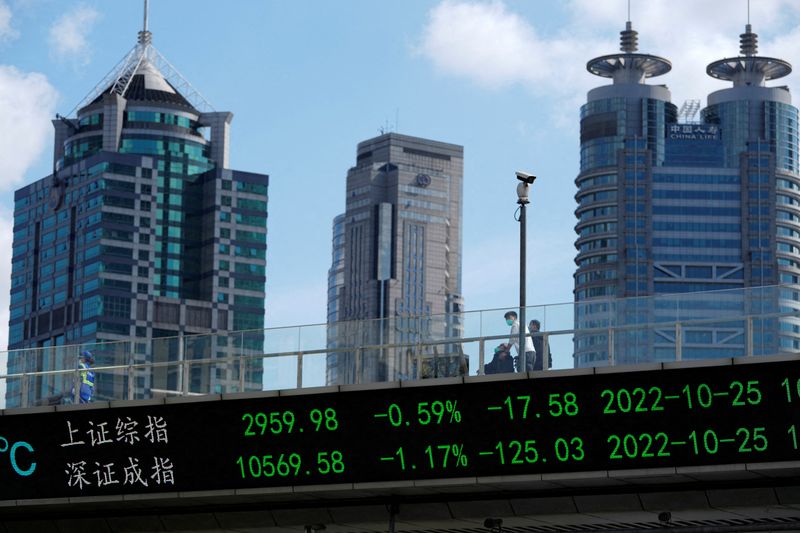
By Jamie McGeever
(Reuters) - A look at the day ahead in Asian markets from Jamie McGeever, financial markets columnist.
Asian markets are set for a nervous open on Monday as worries mount that last week's equity selloff could accelerate, financial conditions continue to tighten, and investors brace for a raft of economic data from China throughout the week.
There seems to be no obvious market impact from the G20 summit in India, and politically-influenced trading will likely be dominated by U.S.-China tensions. Last week Apple (NASDAQ:AAPL)'s 6% slide wiped $180 billion off its market cap on news that Beijing had banned government employees from using iPhones at work.
Broader market sentiment is fragile. The Nasdaq shed 2% last week, and the S&P 500, MSCI World and MSCI Asia ex-Japan Index all fell more than 1%.
Tightening financial conditions from high bond yields and a strong dollar, and unease about the looming lag effects of the Fed's rate hikes are coming together in what has been historically a notoriously volatile month for stocks.
According to Goldman Sachs's real-time indexes, financial conditions in China, emerging markets and globally are now the tightest since last November.
The dollar is at a six-month high, Asian currencies are feeling the heat, and traders are on intervention alert - India's rupee posted a record closing low on Thursday and the Japanese yen, Philippine peso and Thai Baht are at their lowest levels this year.
Currencies may also get direction from a sprinkling of key economic indicators across the region this week - Indian trade and inflation, Australian unemployment, Indonesia retail sales, and Japanese industrial production and machinery orders.
The economic data spotlight this week will shine on China. Beijing often concentrates the release of key indicators into short bursts - often referred to as the 'Chinese data dump' - but this one is particularly heavy.
Money supply, loan growth, social financing (a broad measure of credit and liquidity in the economy), retail sales, industrial production, unemployment, house prices and fixed asset investment are all due for release by September 15.
That follows producer and consumer price inflation figures on Saturday that suggest disinflationary pressures are sticky. Annual PPI was negative for the 11th month in a row, and annual CPI rose only 0.1%, undershooting forecasts of a 0.2% increase.
The state of China's economy will be much clearer by the end of the week, as will the scale of the task facing authorities to provide the necessary monetary and fiscal stimulus to keep Beijing's goal of 5% GDP growth this year in sight.
But complicating this is the yuan, which is at a 16-year low. Further policy easing will put it under even heavier downward pressure, risking a spiral of FX depreciation, asset market weakness and capital flight.
Here are key developments that could provide more direction to markets on Monday:
- Malaysia industrial production (July)
- Japan money supply (August)
- U.S. 3-year note auction
(By Jamie McGeever; Editing by Diane Craft)
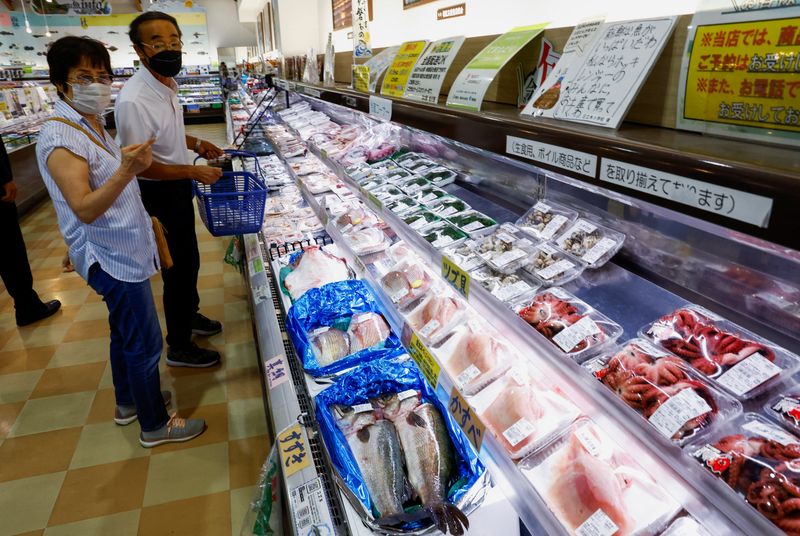
By Leika Kihara and Yoshifumi Takemoto
TOKYO (Reuters) -Japan's economy grew less than initially estimated in the second quarter and wages slumped in July, casting doubt over central bank projections that solid domestic demand will keep the country on course for a recovery.
Capital expenditure and private consumption both fell in the April-June period, revised gross domestic product (GDP) data showed on Friday, underscoring the fragile state of Japan's economy, which is already facing headwinds from weakening Chinese and U.S. growth.
Real wages adjusted for inflation fell in July for a 16th straight month in a sign households continued to feel the pinch from rising prices, separate data showed, boding ill for consumption.
"Weak exports to China may be making Japanese manufacturers cautious about investing. The hope is that service-sector firms will pick up the slack, though sluggish consumption could discourage them to spend money, too," said Takeshi Minami, chief economist at Norinchukin Research Institute.
Japan's economy grew an annualised 4.8% in April-June, the revised data showed, down from a preliminary estimate of 6.0% growth and below market forecasts for a revised 5.5% expansion.
The main factor behind the downgrade was a 1.0% drop in capital expenditure, compared with a preliminary flat reading, casting doubt on the BOJ's view that robust corporate spending will underpin Japan's post-pandemic economy. The revised decline was bigger than a median market forecast for a 0.7% fall.
Private consumption, which makes up more than half of the economy, fell 0.6% quarter-on-quarter in the April-June period, compared with a preliminary 0.5% decline.
Exports remained solid in April-June with net external demand contributing 1.8% points to GDP growth, unchanged from the preliminary reading.
But shipments to China slumped 13.4% in July to mark the 8th straight month of falls. Overall exports slid 5.0% year-on-year in the first half of August after a 0.3% decline in July, suggesting the global slowdown was taking a toll on the economy.
As weak domestic demand led to declines in imports, Japan's current account surplus logged a record amount for the month of July, separate data released on Friday showed.
"I won't be surprised if Japan suffers two straight quarters of contraction during the rest of this year," said Minami of Norinchukin. "The chance of an early end to ultra-loose monetary policy is diminishing."
Japan's economy has seen a delayed recovery from the COVID-19 pandemic this year, as rising living costs faltering global demand cloud the outlook.
Given such uncertainties, Bank of Japan policymakers have stressed their resolve to keep monetary policy ultra-loose until the recent cost-driven inflation turns into price rises driven by domestic demand and higher wage growth.

By Nikunj Ohri and David Lawder
NEW DELHI (Reuters) -U.S. Treasury Secretary Janet Yellen said on Friday the United States was willing to work with India to help craft a communique at the end of the Group of 20 Summit in New Delhi over the weekend, but it would be a challenge.
"So I understand that this is challenging to craft such language, but I know the negotiators are discussing it, and working hard to do so and we stand ready certainly to work with India to try to craft a communique that successfully addresses this concern," Yellen told reporters at a briefing.
Analysts say deeper and more entrenched divisions over Russia's war in Ukraine risk derailing progress on issues such as food security, debt distress and global cooperation on climate change when the world's most powerful nations meet this weekend in New Delhi.
In her prepared comments, Yellen said she will work to build support to increase lending resources for the International Monetary Fund and the World Bank to help member countries deal with multiple global challenges, including new IMF quota resources.
She will seek to build G20 support for an "equi-proportional" increase in IMF quota funds paid-in by member countries, which would increase IMF lending resources, but not immediately change its shareholding structure.
At the briefing, Yellen said there was significant progress made on international debt relief efforts.
"International debt and providing relief to countries that are overindebted partly because of the impact of Russia’s war against Ukraine, but also the high interest rate environment, I believe we're beginning to make significant progress there. So I do see the G20 as a very effective forum," she said.
Yellen also said the United States has asked the U.S. Congress for permission to lend $21 billion to IMF trust funds, including one for the poorest countries, which "desperately needs more resources."
She highlighted progress on efforts over the past year by the World Bank and other multilateral development banks to vastly expand lending resources and help tackle climate change, pandemics and other global crises.
Near-term balance sheet changes under consideration could unlock an additional $200 billion over the next decade, she said.
More resources could come from medium-term steps recommended by a G20 capital adequacy review, including the use of callable capital that is pledged, but not paid-in, to back lending.
"Those are crucial additional resources for reducing poverty, advancing global health security and combating climate change," Yellen said.
The U.S. Treasury chief also said she will work to strengthen international support for Ukraine at the G20 gathering, saying it was "critical that we continue to provide timely economic assistance" through such measures as the IMF's $15.5 billion Ukraine loan program and the European Union's proposed 50 billion-euro support package through 2027.
"Even without Russia's active participation and the tensions the war has created, I still see that G20 is highly effective," Yellen said.
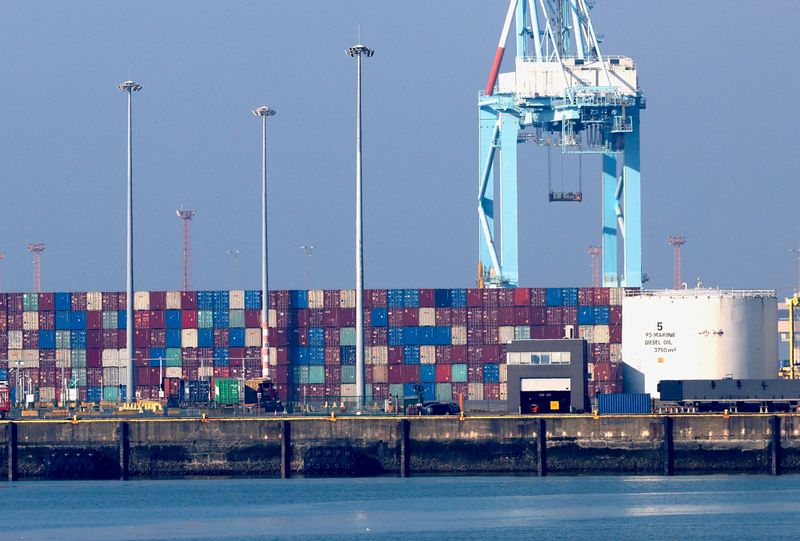
By John Kemp
LONDON (Reuters) -Global industrial production and containerised freight flows remained in the doldrums at the start of the third quarter, confounding predictions earlier in the year for a strong rebound.
Manufacturers and distributors in North America and Europe were struggling to reduce excess inventories after the post-pandemic rotation from goods to services spending.
Rising interest rates and a cost-of-living squeeze have also dampened expenditure on expensive long-lived durable items.
Global industrial output was up by less than 1% in the second quarter of 2023 from the same period in 2022, according to the Netherlands Bureau for Economic Policy Analysis (CPB).
Such slow growth has been associated in the past with cycle-ending recessions or pronounced mid-cycle slowdowns (“World trade monitor”, CPB, August 25).
The volume of world trade was actually down by almost 2% compared with the same period a year earlier, a retreat that has always been associated in the past with outright recession.
As a result, global growth is entirely dependent on the services sector as consumers boost spending on travel, tourism and other personal services in reaction to the lockdowns of 2020-2022.
The commodities side of the economy is stuck in the doldrums as households pare back pandemic-era spending on products and businesses try to clear excess stocks.
Chartbook: Global container freight
In the United States, the volume of container trade handled through the nine largest ports in July was the lowest for the time of year since 2017.
The volume of container freight hauled on the major railroads in June was the lowest for the time of year since 2012.
Road freight has held up better than rail but it was still down by almost 1% in June compared with a year earlier.
In Japan, the volume of freight handled through Narita airport in the first seven months as a whole was the lowest for over a decade, with the exception of the pandemic’s first wave in 2020.
In the United Kingdom, freight through Heathrow airport had fallen in the first seven months to the lowest since 2007 with the exception of the pandemic in 2020 and the recession in 2009.
Air freight is considerably more expensive than ground shipping so it is used only for high-value items and when speed is a priority.
But with inventories high throughout the supply chain there is no urgency for deliveries and air cargo carriers have struggled to compete.
Surface freight volumes appear to be growing a bit more in Asia, boosted by China’s re-opening after particularly severe lockdown restrictions and devastating exit wave from the epidemic.
Container trade through the port of Singapore, a major transshipment point for the region, has climbed to record levels.
Throughput hit 3.43 million twenty-foot equivalent units (TEUs) in July 2023 up from 3.29 million in July 2022 and 3.24 million in July 2019.
In other parts of Asia, the picture is more mixed. China’s coastal ports handled 23.7 million TEUs in July 2023 up by less than 2% from 23.3 million a year earlier.
But the country’s internal freight carried by road, rail, air and river shipping reached a record 2,016 billion tonne-kilometres in July up by more than 7% from 1,881 billion a year ago.
South Korea’s KOSPI-100 equity index, which is a good proxy for trends in global trade, given its high-weighting of exported-oriented firms, has been up year-on-year since June.
Rising share prices would be consistent with an improving outlook for global trade, but the evidence for it so far is limited.
Globally, industrial activity and freight still seem to be flatlining after the merchandise-led boom associated with the pandemic gives way to a services-led post-pandemic period.
The worst of the freight downturn between the middle of 2022 and the start of 2023 appears to be over, but there is no sign of a significant recovery.
Related columns:
- Global container freight stuck in doldrums (June 23, 2023)
- Global freight shows signs of bottoming out (April 27, 2023)
John Kemp is a Reuters market analyst. The views expressed are his own
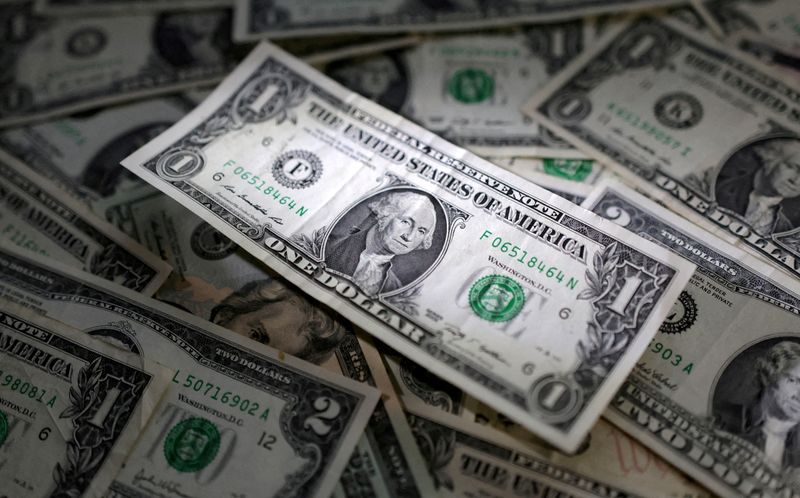
By Rae Wee
SINGAPORE (Reuters) - The dollar was headed for its longest weekly winning streak in nine years on Friday, bolstered by a resilient run of U.S. economic data that has also put the end of the Federal Reserve's rate-hike cycle into question.
In Asia, traders were keenly watching moves in the Chinese currency, after the onshore yuan tumbled to a 16-year low in the previous session.
The U.S. dollar index, which measures the greenback against its major peers, steadied at 105.02 in early trade, not far from the previous session's six-month high of 105.15.
The index was on track to extend its gains into an eighth straight week, and is up 0.7% so far.
The euro, the largest component in the dollar index, was staring at eight straight weeks of losses, with the single currency last marginally higher at $1.0701, after having fallen to a three-month low of $1.0686 on Thursday.
"This week's story was very much about the resilience we've seen in the data ... the market's psychology is that things just look so much better in the U.S. than they do elsewhere in the world," said Ray Attrill, head of FX strategy at National Australia Bank (OTC:NABZY).
Data out this week showed the U.S. services sector unexpectedly gained steam in August and that jobless claims hit their lowest level since February last week, while in the euro zone, industrial production in Germany, Europe's largest economy fell by slightly more than expected in July.
"Comparing the current growth fundamentals of Europe and the U.S., the U.S. still looks superior," said Attrill.
Sterling similarly languished near Thursday's three-month low and last bought $1.2484, set to clock a weekly loss of more than 0.8%.
IN THE DOLDRUMS
The offshore yuan edged 0.05% higher to 7.3379 per dollar, but remained not far from a 10-month low of 7.3490 hit in August. It is on track for a weekly loss of nearly 1% against the dollar, its worst week in about a month.
China's yuan has depreciated steadily since February as the faltering post-pandemic economic recovery and widening yield gap with other economies, particularly the United States, affected capital flows and trade.
The onshore yuan, which touched its weakest level since 2007 on Thursday, has fallen nearly 6% against the dollar so far this year to become one of the worst performing Asian currencies alongside its offshore counterpart.
"I expect USD/CNY to rise to 7.50 by mid-2024 because no major fiscal stimulus appears to be forthcoming, and thus monetary policy will need to continue bearing part of the burden of supporting the economy," said Alvin Tan, head of Asia FX strategy at RBC Capital Markets.
The yuan's rapid decline has prompted authorities to step in to slow the pace of its depreciation.
The Australian dollar, often used as a liquid proxy for the yuan, was last 0.07% higher at $0.6381, but eyed a weekly loss of more than 1%.
The New Zealand dollar similarly was on track to lose roughly 0.9% for the week and last bought $0.5890.
Also on traders' radars was a struggling yen, which rose 0.15% to 147.06 per dollar but remained on the weaker side of the key 145 level which prompted an intervention by Japanese authorities last year.
While officials have stepped up their jawboning efforts to defend the yen, they have also continued to stress the need to maintain the Bank of Japan's ultra-loose monetary policy.

By David Lawder
WASHINGTON (Reuters) - The International Monetary Fund and World Bank on Thursday issued a rare joint statement pledging to step up their cooperation to address climate change, debt vulnerabilities and countries' digital transitions.
The statement, released ahead of a G20 leaders summit in India this week, said the two institutions can help address mounting challenges facing the global economy - from increasing climate disasters to slowing growth and geopolitical fragmentation - by working together.
"The Bretton Woods institutions, with their universal membership and specialist expertise, are well-placed to make a critical contribution to help countries tackle these challenges," IMF Managing Director Kristalina Georgieva and World Bank President Ajay Banga said in the joint statement.
The IMF and World Bank were established in 1944 at a meeting in Bretton Woods, New Hampshire.
Banga is scheduled to attend his first G20 summit after starting as the World Bank's new president in June, with a mandate to expand the lender's resources to help tackle climate change, pandemics, fragility and other global crises alongside its traditional anti-poverty mission.
U.S. President Joe Biden at the G20 summit intends to focus heavily on reforming the World Bank and other multilateral development lenders to scale up their lending for climate and infrastructure. The U.S. sees the institution as an important counterbalance to China's overseas lending.
The joint IMF-World Bank statement said the two institutions would collaborate on climate change on a "more structured and institutionalized footing.This includes formalizing regular meetings of the new Bank-Fund Climate Advisory Group every two months to consider climate-related developments on key projects, including loans through the IMF's new Resilience and Sustainability Trust, which provides middle-income countries with financing on climate resilience and transition projects.
DEBT VULNERABILITIES
The two institutions also said they will incorporate climate considerations into their work on debt sustainability for low-income countries.
The IMF and World Bank have worked closely on debt sustainability issues, both pushing for improved restructuring frameworks. They launched a sovereign debt roundtable last year to standardize restructuring concepts and speed up debt treatments.
"We will enhance our joint work to help prevent further build-up of debt vulnerabilities, assisting countries to strengthen debt management and transparency and public finances," Georgieva and Banga said, adding that they would also deepen support to creditors and debtors engaged in debt restructurings.
On the digital transition, the two institutions said they would collaborate to help countries to connect their citizens to online services and reduce barriers to digital inclusion.
"We will step up our joint work to help countries increase the effectiveness of revenue collection and expenditure systems and reap the benefits of new digital technologies while mitigating the risks," Georgieva and Banga said.
That will include improving cross-border payment systems while ensuring that such innovations spur growth, poverty reduction and job creation, they added.

By Ann Saphir and Michael S. Derby
(Reuters) -U.S. economic growth was modest amid a cooling labor market and slowing inflation pressures in July and August, a Federal Reserve report published on Wednesday showed, buttressing expectations that the central bank was either done, or close to being done, with interest rate increases.
"Most Districts reported price growth slowed overall," the Fed said in its latest "Beige Book" summary of surveys and interviews conducted across its 12 districts through Aug. 28. It added that "nearly all districts indicated businesses renewed their previously unfulfilled expectations that wage growth will slow broadly in the near term."
The U.S. central bank is widely expected to leave its benchmark overnight interest rate in the current 5.25%-5.50% range at the end of its Sept. 19-20 policy meeting, while leaving open the door to a final quarter-percentage-point hike before the end of the year.
Financial markets are pricing about even odds that the Fed's rate-hike campaign, begun 18 months ago, is over.
Fed officials are, however, keeping their options open. They believe that the 5.25 percentage points of rate hikes delivered since March 2022 are slowing the economy, capping job growth and most importantly slowing inflation, which soared to a 40-year high last year.
Data since the last Fed rate hike six weeks ago has tended to support that view, with the economy adding an average of 150,000 jobs per month over the last three months, down sharply from the prior three months. Inflation, as gauged by the Fed's preferred measure, was 3.3% in July, down from 7% last summer.
That's why even a hawkish policymaker like Fed Governor Christopher Waller was able to say that the central bank has time to take in new data before it decides whether it has to raise rates again, or can hold them at current levels.
Earlier on Wednesday, Boston Fed President Susan Collins also said the central bank has the space to be patient, while acknowledging that inflation pressures, though easing, still remain too high.
Collins, however, added that she did not believe a "significant slowdown is required" to get inflation down and "price stability is achievable with an orderly slowdown and only a modest unemployment rate increase - ideally preserving some of the favorable labor supply dynamics."
Still, prices continue to rise faster than the Fed's 2% goal, employers are adding many more than the monthly 100,000 jobs needed to meet population growth, and economic output appears to be far outpacing the less-than-2% annual growth rate Fed officials say is sustainable in the long run.
Many of the Fed's 12 regional banks found that amid decelerating price pressures, the ebbing was most notable in goods-centric parts of the economy, according to the latest Beige Book report.
CONSUMERS TURN TO BORROWING
The report also flagged some fraying around the edges of the consumer sector, noting that a rising number of households had exhausted savings built up during the coronavirus pandemic and were turning more to borrowing. At the same time, the report found evidence more households were struggling to manage debt.
The New York Fed district said migrants were putting strains on the local safety net. The report said "housing affordability, homelessness, and food insecurity continued to challenge communities" in the San Francisco Fed district, adding that "temporary housing shelters and food banks saw increased demand in recent weeks, especially from older adults."
The report noted that housing remains an issue and that the supply for single-family homes "remained constrained." Home building was picking up, the Fed said, but building affordable properties is being strained by high financing costs and rising insurance premiums.
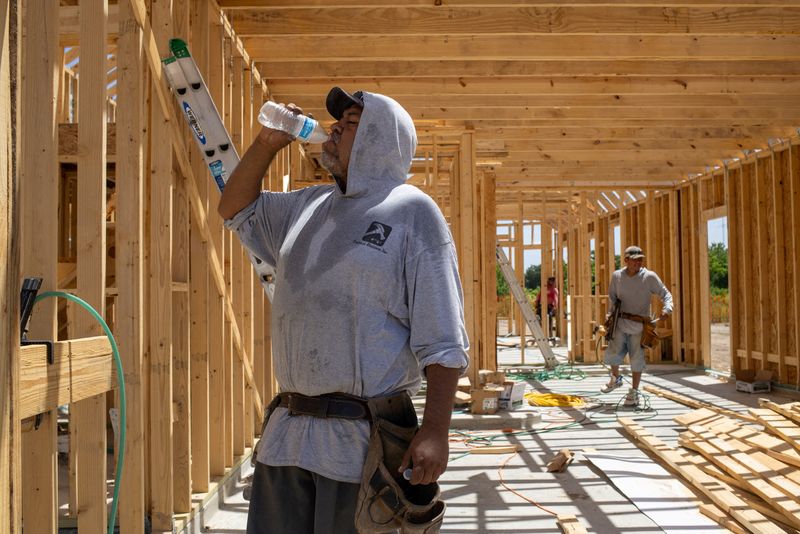
By Mark John
(Reuters) - As Texas baked in this summer's record temperatures, local UPS driver Chris Begley started feeling unwell before collapsing at a customer's premises. The 57-year-old's death in hospital was announced in late August - just as his trade union was ratifying a deal with UPS on improved heat protections.
"Chris Begley should still be alive to experience them," the Teamsters union said in a statement of provisions such as a promise to include air conditioning in new delivery vans from next year and to retrofit existing vehicles.
In a statement to local media, UPS said it was cooperating with the authorities as they investigated the cause of death. "We train our people to recognize the symptoms of heat stress, and we respond immediately to any request for help," it said.
As global warming leads to more frequent spells of extreme heat around the world, workers are among the most exposed to serious health risks because their livelihoods often depend on them carrying on regardless.
At the same time, studies show that productivity starts to be impaired at temperatures above 24-26 degrees Celsius (75-79 degrees Fahrenheit) and, for some tasks, slashed by half from around 33-34C - levels repeatedly exceeded in a year which included the hottest July on record.
"Unlike some occupational health and safety risks you see a direct impact (from heat) on the health of workers and a direct impact on productivity," said Halshka Graczyk, a specialist on the issue at the International Labour Organization (ILO).
"So does it make sense for the employer to keep a job site running that day if it is more than 35C and productivity is less than 50% of what they are expecting?" Graczyk said of an awkward cost-benefit ratio that more workplaces will start to face.
WORKER RIGHTS
Even on the optimistic assumption that the world hits its Paris Agreement goal of capping warming at 1.5C, productivity losses will amount to 2.2% of global work hours or $2.4 trillion in output by 2030, the ILO estimates.
But finding the point at which employer costs can be minimised without compromising worker welfare is all the harder given the lack of clear data, uneven regulation, and the unequal way that workers around the world will experience heat stress.
Not surprisingly, white-collar workers in air-conditioned offices will be less affected: the big impact will remain initially on outdoor workers in sectors from construction to agriculture and in particular those in the Global South.
Among the most exposed will be the world's 170 million migrant workers. Chaya Vaddhanaphuti, a researcher at Chiang Mai University in Thailand, said his studies of migrant workers from Myanmar underlined their vulnerability.
"These labourers tend to display extra stoicism and endurance - partly because they need to show to their Thai bosses that they can work and hence still get hired," he said.
"This puts them in more danger during the heatwave period and they often lack any paperwork or access to medical services."
An internationally agreed ILO convention grants workers a right to leave a workplace without fear of retaliation if they have "reasonable justification" to believe they are in danger - but labour advocates say few workers know of the convention or dare use it.
Many European and other usually temperate countries still have no laws establishing maximum work temperatures. Where they exist - such as in China, with its decade-old 40C cap - monitoring and enforcement is patchy.
Often that is because workplace regulators lack resources: the U.S. Occupational Health and Safety Authority (OCHA) would need 165 years to check each workplace in its remit, estimates labour advocacy group National Employment Law Project (NELP).
"There has to be both carrots and sticks - and without enforcement there are not enough sticks," said Anastasia Christman, senior policy analyst at NELP.
ROLE FOR AUTOMATION
While work temperature caps may prevent some casualties, they do not account for the fact that workers experience stress differently, according to their job role and health profile.
"The number on the thermostat is not as crucial as assessing the risks and talking to the workforce," said Owen Tudor, Deputy General Secretary, International Trade Union Confederation.
Consultations might yield relatively cheap fixes: Tudor cited the example of a meatpacking plant which had found it could reduce heat transfer from worker to worker simply by spacing them out more.
Other solutions have wider societal repercussions. The oft-cited switching of work hours to the cooler hours of early morning or late evening leaves workers having to rearrange childcare or facing limited public transport options.
Automation will have a role to play. French winemaker Jerome Volle harvested before dawn this year - mechanising much of the process - to avoid daytime temperatures of 42C which, he told Reuters, "strain both plant and worker".
Heat exposure is already emerging as a source of worker grievance - be it the strikes by staff at the Greek Acropolis tourist site in July, or the successful suing of a Chinese employer last year for the heat stroke death of a cleaner.
As temperatures rise further, pay and performance practices currently favoured in some sectors - for example piece work and output targets that discourage workers from taking rest breaks - may prove indefensible. And if an extreme weather event like a tornado destroys a factory, should workers still get paid?
"Climate change is such a paradigm shift that all of us need to rethink these legacy economic assumptions," said NELP's Christman. "Just doing workplace protection standards won't be enough."

